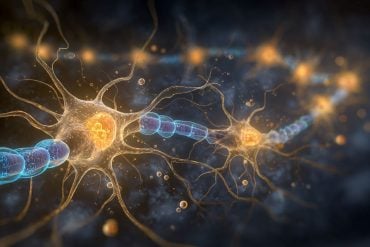Summary: Researchers have unveiled the mystery behind neuron death in Alzheimer’s disease. A groundbreaking study reveals that neurons undergo a programmed cell death, necroptosis, when exposed to amyloid plaques and tau tangles, hallmark proteins linked to Alzheimer’s. The study pinpoints an RNA gene called MEG3 as a potential key player in this process. This pivotal discovery provides promising pathways for future treatments.
Key Facts:
- Neurons exposed to amyloid plaques and tau tangles initiate a cell death process called necroptosis.
- An RNA gene, MEG3, has been identified as a critical component in this neuron death mechanism, as seen in Alzheimer’s patients.
- Utilizing a new model, researchers observed that only human neurons showed Alzheimer’s characteristics, suggesting human-specific factors in the disease.
Source: Medical Research Council
A research team has finally discovered how neurons die in Alzheimer’s disease (AD). The team is led by Professor Bart De Strooper at VIB-KU Leuven and the UK Dementia Research Institute (UK DRI) at UCL and Dr. Sriram Balusu at VIB-KU Leuven.
A subject of scientific discussion in recent decades, a breakthrough research paper illustrates how neurons initiate a programmed form of cell death, known as necroptosis, when they are exposed to amyloid plaques and tau tangles. This is a hallmark misfolded proteins implicated in Alzheimer’s.

More importantly, the research team was able to prevent the death of neurons, rescuing them in the process. The discovery opens new pathways for potential future treatments.
The study sheds light on the previously murky waters of AD, revealing a potential key player in neuronal loss, an RNA gene called MEG3, and the process of necroptosis. These findings are an important step forward in furthering our understanding of the basic mechanisms underlying this complex and often misunderstood disease.
The paper, titled “MEG3 activates necroptosis in human neuron xenografts modeling Alzheimer’s disease,” is published in Science.
Professor Bart De Strooper, group leader at UK DRI at UCL and VIB-KU Leuven Center for Brain and Disease Research, said, “Our study sheds light on the previously murky waters of Alzheimer’s disease, revealing a potential key player in neuronal loss—an RNA gene called MEG3, and the process of necroptosis. These findings are an important step forward in furthering our understanding of the basic mechanisms underlying this complex and often misunderstood disease.”
A new model to crack the Alzheimer’s enigma
One of the key challenges in understanding AD has been connecting its defining hallmarks, amyloid plaques, tau tangles, and death of neurons, to each other.
Most mouse models used in research couldn’t naturally replicate these features, leaving scientists with unanswered questions about how they relate to disease progression.
Sriram Balusu, postdoctoral researcher in the De Strooper lab and first author of the paper, said, “To bridge this gap, we created a new model, we implanted both healthy human and mouse neurons into the brains of AD mouse models. The human cells degenerated much like their counterparts in the human brain, allowing us to study them during brain aging and shine a new light on the processes underlying AD.”
Remarkably, only the human neurons, and not their rodent counterparts, displayed Alzheimer’s features seen in the brains of patients, including tau tangles, and significant neuronal cell loss.
This suggests that there may be human-specific factors at play in Alzheimer’s that standard mouse models can’t replicate.
Understanding why mouse neurons are more resilient to amyloid pathology will not only help model the disease better but might also stimulate research into pathways that protect against neurodegeneration.
The culprit behind brain cell loss
Using their new model, the team probed deeper, seeking answers on how neurons die in Alzheimer’s.
The study revealed a critical breakthrough, a pathway known as necroptosis, a form of programmed cell death, was activated in the model, leading to death of neurons.
But the discovery went even further. The researchers saw that levels of a molecule known as MEG3 were strongly increased in human neurons, as seen in Alzheimer’s patients.
Strikingly, just the presence of MEG3 alone was enough to trigger the pathway of necroptosis in human neurons in a lab setting.
The study also found that by reducing MEG3 and preventing necroptosis, researchers could in turn prevent the death of cells. More research is needed to understand how exactly MEG3 triggers necroptosis, but this discovery represents a crucial advancement in understanding how Alzheimer’s leads to the loss of neurons in the brain.
Professor De Strooper said, “Necroptosis is already an active area of drug development in cancer and ALS. While there’s much more to explore, our findings open up promising avenues for potential therapies targeting AD, alongside traditional approaches aimed at amyloid and tau.”
About this Alzheimer’s disease research news
Author: Bart De Strooper
Source: Medical Research Council
Contact: Bart De Strooper – Medical Research Council
Image: The image is credited to Neuroscience News
Original Research: Closed access.
“MEG3 activates necroptosis in human neuron xenografts modeling Alzheimer’s disease” by Bart De Strooper et al. Science
Abstract
MEG3 activates necroptosis in human neuron xenografts modeling Alzheimer’s disease
Neuronal cell loss is a defining feature of Alzheimer’s disease (AD), but the underlying mechanisms remain unclear. We xenografted human or mouse neurons into the brain of a mouse model of AD.
Only human neurons displayed tangles, Gallyas silver staining, granulovacuolar neurodegeneration (GVD), phosphorylated tau blood biomarkers, and considerable neuronal cell loss.
The long noncoding RNA MEG3 was strongly up-regulated in human neurons. This neuron-specific long noncoding RNA is also up-regulated in AD patients. MEG3 expression alone was sufficient to induce necroptosis in human neurons in vitro.
Down-regulation of MEG3 and inhibition of necroptosis using pharmacological or genetic manipulation of receptor-interacting protein kinase 1 (RIPK1), RIPK3, or mixed lineage kinase domain-like protein (MLKL) rescued neuronal cell loss in xenografted human neurons.
This model suggests potential therapeutic approaches for AD and reveals a human-specific vulnerability to AD.






